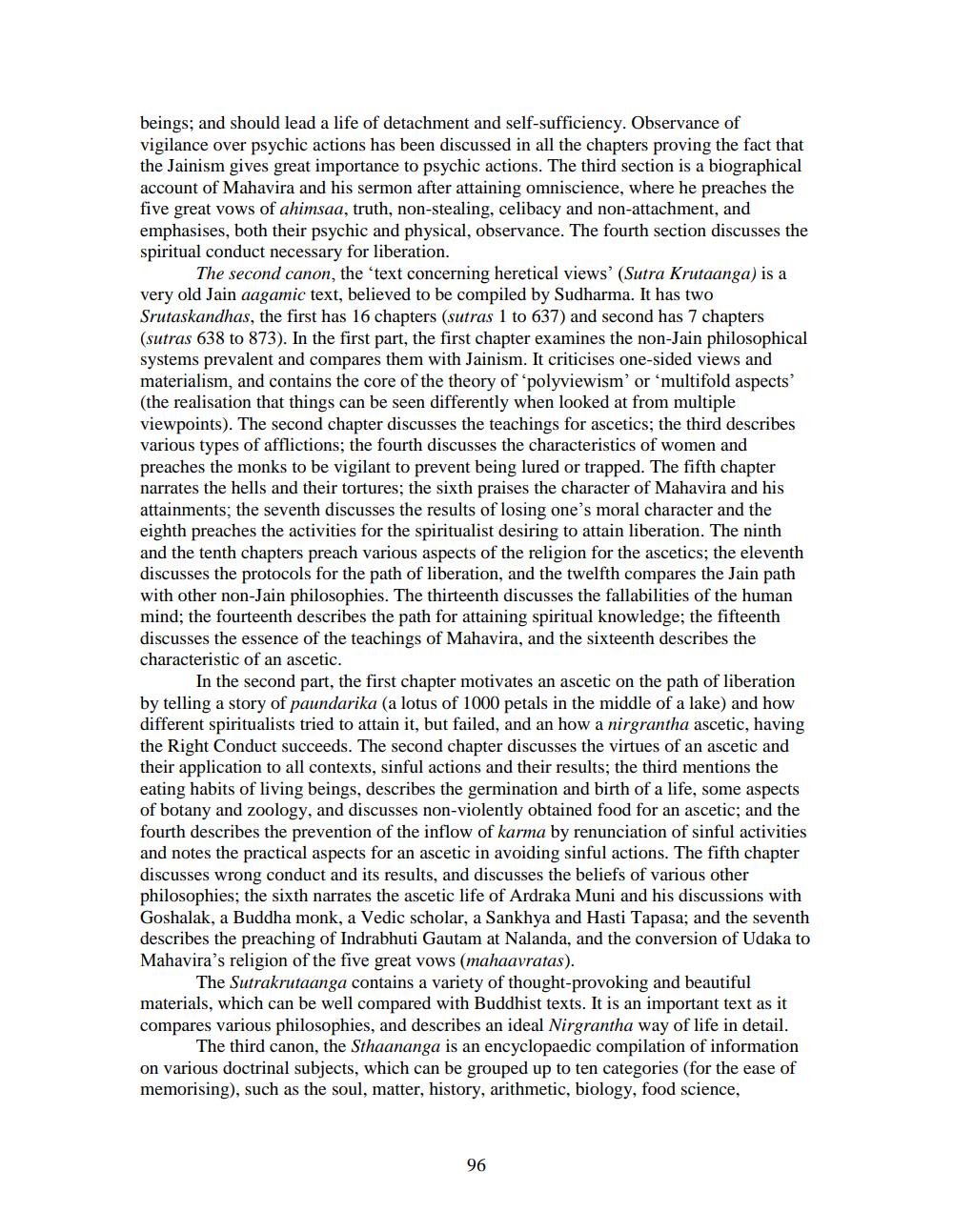________________
beings; and should lead a life of detachment and self-sufficiency. Observance of vigilance over psychic actions has been discussed in all the chapters proving the fact that the Jainism gives great importance to psychic actions. The third section is a biographical account of Mahavira and his sermon after attaining omniscience, where he preaches the five great vows of ahimsaa, truth, non-stealing, celibacy and non-attachment, and emphasises, both their psychic and physical, observance. The fourth section discusses the spiritual conduct necessary for liberation.
The second canon, the 'text concerning heretical views' (Sutra Krutaanga) is a very old Jain aagamic text, believed to be compiled by Sudharma. It has two Srutaskandhas, the first has 16 chapters (sutras 1 to 637) and second has 7 chapters (sutras 638 to 873). In the first part, the first chapter examines the non-Jain philosophical systems prevalent and compares them with Jainism. It criticises one-sided views and materialism, and contains the core of the theory of 'polyviewism' or 'multifold aspects' (the realisation that things can be seen differently when looked at from multiple viewpoints). The second chapter discusses the teachings for ascetics; the third describes various types of afflictions; the fourth discusses the characteristics of women and preaches the monks to be vigilant to prevent being lured or trapped. The fifth chapter narrates the hells and their tortures; the sixth praises the character of Mahavira and his attainments; the seventh discusses the results of losing one's moral character and the eighth preaches the activities for the spiritualist desiring to attain liberation. The ninth and the tenth chapters preach various aspects of the religion for the ascetics; the eleventh discusses the protocols for the path of liberation, and the twelfth compares the Jain path with other non-Jain philosophies. The thirteenth discusses the fallabilities of the human mind; the fourteenth describes the path for attaining spiritual knowledge; the fifteenth discusses the essence of the teachings of Mahavira, and the sixteenth describes the characteristic of an ascetic.
In the second part, the first chapter motivates an ascetic on the path of liberation by telling a story of paundarika (a lotus of 1000 petals in the middle of a lake) and how different spiritualists tried to attain it, but failed, and an how a nirgrantha ascetic, having the Right Conduct succeeds. The second chapter discusses the virtues of an ascetic and their application to all contexts, sinful actions and their results; the third mentions the eating habits of living beings, describes the germination and birth of a life, some aspects of botany and zoology, and discusses non-violently obtained food for an ascetic; and the fourth describes the prevention of the inflow of karma by renunciation of sinful activities and notes the practical aspects for an ascetic in avoiding sinful actions. The fifth chapter discusses wrong conduct and its results, and discusses the beliefs of various other philosophies; the sixth narrates the ascetic life of Ardraka Muni and his discussions with Goshalak, a Buddha monk, a Vedic scholar, a Sankhya and Hasti Tapasa; and the seventh describes the preaching of Indrabhuti Gautam at Nalanda, and the conversion of Udaka to Mahavira's religion of the five great vows (mahaavratas).
The Sutrakrutaanga contains a variety of thought-provoking and beautiful materials, which can be well compared with Buddhist texts. It is an important text as it compares various philosophies, and describes an ideal Nirgrantha way of life in detail.
The third canon, the Sthaananga is an encyclopaedic compilation of information on various doctrinal subjects, which can be grouped up to ten categories (for the ease of memorising), such as the soul, matter, history, arithmetic, biology, food science,




